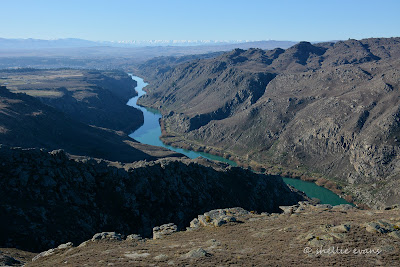The Daniel O’Connell Bridge (1880) crosses the Manuherikia River just down the road from where we are in Omakau. The single lane wooden bridge is one of the last surviving suspension bridges in Central Otago.
The bridge is part of a loop road off the main highway which passes through the tiny historic settlement of Ophir. The town sprang into life overnight when gold was discovered on the property of a local runholder, Charles Black in 1863. In less than 3 months thousands of miners occupied what became known as Blacks Diggings. It was shortened to Blacks – a name that remained with the school and the hotel in spite of an official name change to Ophir in 1875.
In its heyday, Ophir was the commercial & social centre for the district but when the gold ran out so did the population. The final blow came in 1904 when the railway line by-passed the town in favour of the farming community at Omakau just across the river. Ophir sank into obscurity which probably helped save many of its historic buildings. Nowadays the village has become popular again, with tourists, many from the Rail Trail, keen to sample the towns history and stay at the accommodation houses dotted along the main street. A main street that hides its charms well.
Ophir Peace Memorial Hall (1926) - has an excellent dance floor and is still used for many functions and events.
Ophir Post Office (1886) - it still operates as a post office agency for between 9am and noon each day.
Ophir Jail (1900) - This small wooden 2 cell jail was located beside the policeman’s house. After a new police station was built in Omakau in the late 1940s the jail was no longer used. It was shifted off site and became a sleep-out in Omakau before being returned and restored.
The Courthouse (1884) – the building reflects the optimism that Ophir would remain a town long after the gold ran out. The design is the same as the Alexandra and Clyde courthouses.
The Old Drapery was both shop and living quarters.
The Cottage Hospital was most likely both the hospital and doctor’s residence.
This large stone building was originally a grocery store at one end and a butchers shop at the other with the owner living in the residential part at the back.
The buildings roof and front were altered in the 1960s when it became a service station. In 2011 it underwent a complete restoration and is now a restaurant and offers accommodation.
The Bank (1886) - at one stage Ophir had two banks but only one has survived. The former Bank of New South Wales building has been substantially modified since its conversion to a private home.
Roadside characters - A boy and his dog
A few of the private residences along the street, including Kintail House (1917) and the entrance to the Bakery (1880s) where the buildings have been restored and are now used as a homestay -
Stone Barn with a iron lean-to and a two-stall stable behind. In early times, various horse drawn vehicles were built in the barn by the McKnight brothers and it was also used as a smithy.
Union Church (aka St Andrews Predbyterian Church), a simple gothic church opened for worship in 1897 and closed in 2008. It is now in private ownership.
More buildings from Ophir’s main street- top left, the Policeman’s House & Station (1870s), which is next door to the Courthouse. Larson House (middle left) which is actually two, two roomed cottages, one placed in front of the other and bottom left is McKnights Cottage (c1904), John Mcknight was a local builder, a blacksmith, funeral director & county councillor. He built many of the Ophir’s buildings and also built the Bank of New Zealand building in Omakau. A jack of all trades!
Blacks Hotel (1937) - located at the end of the town, or the beginning depending which way you come, is the art deco style Blacks Hotel. It was established when a new bridge crossing the river to Omakau was built and what was known as the Ophir lane became a highway. That ‘highway’ carries on over the Raggedy Range and into the Ida Valley. Behind the hotel are lovely accommodation units (looking like a shearing gang shed) for rail trail cyclists.
MacTavish’s Hut- a short distance up the ‘highway’ is a restored miner’s hut. The two-roomed hut was built on an acre of mining land owned by Lockhart McTavish.
At one stage the hut was occupied by Clem Daniels, a goldminer who ended his days there at an advanced age. Clem was well known in Ophir, he dressed in a blue suit whenever he walked to town, he also umpired many cricket games, marking the number of balls bowled with his walking stick. It was always obvious when he found gold- he would hold a roaring celebration at the old pub.
I hope you enjoyed your ‘wander’ around Ophir. Many thanks to “Promote Dunstan” for their informative brochure.
So laugh with me now or cry with me now
As you tramp those memoried tracks
For they all lead down to Ophir Town
And the old time town of Blacks
(Todd Symonds)





























































